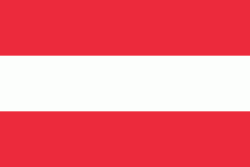Sankt Radegund (Sankt Radegund)
Sankt Radegund, abbreviated St. Radegund, is a municipality in the district of Braunau am Inn in the Austrian state of Upper Austria, named after Saint Radegund. It is situated at the western rim of the Innviertel region, where the Salzach river forms the border to the German state of Bavaria.
Originally a part of the stem duchy of Bavaria, Sankt Radegund together with the Innviertel fell to the Archduchy of Austria according to the rules of the 1779 Treaty of Teschen. In the early 1930s, Joseph Ratzinger, who would later become Pope Benedict XVI, took Sunday walks with his mother to Sankt Radegund "and to other localities on the Austrian side of the Salzach". The village is known as the birthplace of Blessed Franz Jägerstätter, a Catholic farmer and conscientious objector who was executed at Brandenburg-Görden Prison in August 1943. Jägerstätter would eventually be beatified by Pope Benedict XVI on October 26, 2007. Jägerstätter's wife, Franziska Jägerstätter, continued to live in Sankt Radegund up to her death in March 2013, at the age of 100.
Originally a part of the stem duchy of Bavaria, Sankt Radegund together with the Innviertel fell to the Archduchy of Austria according to the rules of the 1779 Treaty of Teschen. In the early 1930s, Joseph Ratzinger, who would later become Pope Benedict XVI, took Sunday walks with his mother to Sankt Radegund "and to other localities on the Austrian side of the Salzach". The village is known as the birthplace of Blessed Franz Jägerstätter, a Catholic farmer and conscientious objector who was executed at Brandenburg-Görden Prison in August 1943. Jägerstätter would eventually be beatified by Pope Benedict XVI on October 26, 2007. Jägerstätter's wife, Franziska Jägerstätter, continued to live in Sankt Radegund up to her death in March 2013, at the age of 100.
Map - Sankt Radegund (Sankt Radegund)
Map
Country - Austria
 |
 |
| Flag of Austria | |
Austria emerged from the remnants of the Eastern and Hungarian March at the end of the first millennium. Originally a margraviate of Bavaria, it developed into a duchy of the Holy Roman Empire in 1156 and was later made an archduchy in 1453. In the 16th century, Vienna began serving as the empire's administrative capital and Austria thus became the heartland of the Habsburg monarchy. After the dissolution of the Holy Roman Empire in 1806, Austria established its own empire, which became a great power and the dominant member of the German Confederation. The empire's defeat in the Austro-Prussian War of 1866 led to the end of the Confederation and paved the way for the establishment of Austria-Hungary a year later.
Currency / Language
| ISO | Currency | Symbol | Significant figures |
|---|---|---|---|
| EUR | Euro | € | 2 |
| ISO | Language |
|---|---|
| HR | Croatian language |
| DE | German language |
| HU | Hungarian language |
| SL | Slovene language |















